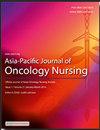淋巴水肿乳腺癌幸存者的上肢症状:潜在分类分析和网络分析
IF 2.8
3区 医学
Q1 NURSING
引用次数: 0
摘要
目的:患有淋巴水肿的乳腺癌幸存者(BCS)上肢出现多种症状,严重影响其生活质量。症状的复杂性和这些症状之间的联系尚不清楚。本研究旨在确定BCS患者的上肢症状亚群和症状网络。方法二级分析纳入了术后BCS患者中三个横断面研究中出现淋巴水肿(定义为肢间围差≥2cm)的个体。采用乳腺癌和淋巴水肿症状体验指数评估上肢症状。进行描述性分析、潜在类分析、逻辑回归分析和网络分析。结果共纳入341例伴有上肢淋巴水肿的BCS。肿胀、沉重和紧绷是最常见的症状。发现了四个明显的潜在类别:“严重症状”组(1类:9.4%),“运动受限和淋巴淤积”组(2类:24.6%),“淋巴淤积”组(3类:37.5%)和“轻度症状”组(4类:28.4%)。伴有腋窝淋巴结清扫、放疗、术后时间较长、无医疗保险的BCS属于轻症组的可能性较小(P <;0.001)。症状网络密度由1级降至4级。每个症状网络的核心症状分别为压痛、僵硬、手臂肿胀和沉重。结论本研究确定了乳腺癌相关淋巴水肿(BCRL)患者上肢症状的四种不同类型及其影响因素。我们的研究结果表明,需要考虑个性化的症状管理方法和对BCRL的支持,考虑到他们特定的症状群和相关的危险因素。本文章由计算机程序翻译,如有差异,请以英文原文为准。
Upper limb symptoms in breast cancer survivors with lymphedema: A latent class analysis and network analysis
Objective
Breast cancer survivors (BCS) with lymphedema experience multiple symptoms in upper limbs that significantly impact their quality of life. The complexity of symptomology and the connection among these symptoms are unclear. This study aimed to identify upper limb symptom subgroups and symptom networks among BCS.
Methods
This secondary analysis included individuals with lymphedema (defined as an inter-limb circumference difference of ≥ 2 cm) from three cross-sectional studies among post-surgery BCS. Upper limb symptoms were assessed by the Breast Cancer and Lymphedema Symptom Experience Index. Descriptive analysis, latent class analysis, logistic regression analysis, and network analysis were performed.
Results
A total of 341 BCS with upper limb lymphedema were included. Swelling, heaviness and tightness were the most prevalent symptoms. Four distinct latent classes were identified: “Severe symptom” group (Class 1: 9.4%), “Movement-limitation and lymph-stasis” group (Class 2: 24.6%), “Lymph-stasis” group (Class 3: 37.5%), and “Mild symptom” group (Class 4: 28.4%). BCS with axillary lymph node dissection, radiotherapy, longer post-surgery duration, and without medical insurance were less likely to belong to the mild symptom group (P < 0.001). Symptom network density decreased from Class 1 to 4. Core symptoms for each symptom network were tenderness, firmness, arm-swelling, and heaviness, respectively.
Conclusions
This study identified four distinct categories of upper limb symptoms and influencing factors among individuals with breast cancer-related lymphedema (BCRL). Our findings suggest the need to consider individualized approaches to symptom management and support for BCRL, taking into account their specific symptom clusters and associated risk factors.
求助全文
通过发布文献求助,成功后即可免费获取论文全文。
去求助
来源期刊

Asia-Pacific Journal of Oncology Nursing
Multiple-
CiteScore
2.80
自引率
11.10%
发文量
136
审稿时长
31 days
 求助内容:
求助内容: 应助结果提醒方式:
应助结果提醒方式:


